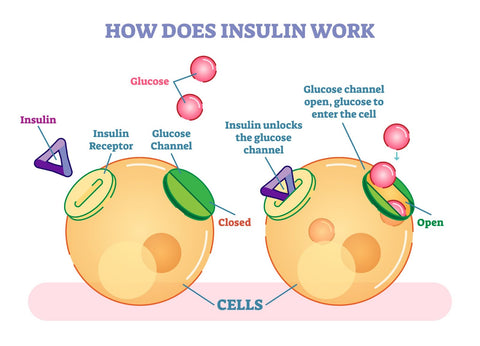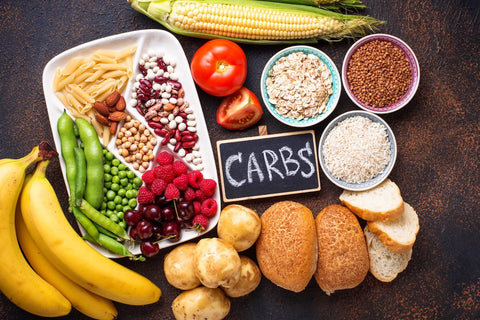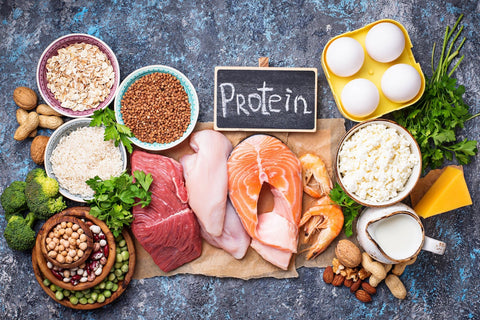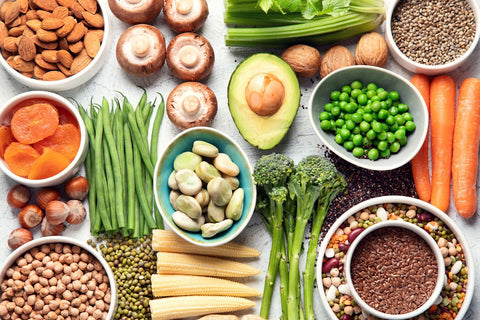Welcome to our comprehensive guide on decoding hyperinsulinemia and understanding the fascinating ways that food affects insulin production. If you're seeking to optimize your health and well-being, particularly in relation to insulin levels, you've come to the right place.
This blog post will delve into hyperinsulinemia, a condition characterized by excessive insulin levels in the bloodstream.
We will explore what hyperinsulinemia is, its potential causes, and the impact it can have on your overall health. But that's not all — we will also uncover food's crucial role in insulin production and how you can make informed choices to support a healthy balance.
Insulin, often called the "master hormone," is a vital component of our body's intricate metabolic system. It plays a crucial role in regulating blood sugar levels, ensuring our cells receive the energy they need to function optimally. However, when insulin levels become imbalanced, it can lead to a range of health issues, including hyperinsulinemia.
Stay tuned for the next sections, where we will dive deeper into the fascinating world of hyperinsulinemia and explore practical strategies to support healthy insulin levels through your dietary choices. Let's unlock the secrets of optimal insulin production together!
What is hyperinsulinemia
Hyperinsulinemia is like a glitch in our body's energy department. It's when too much insulin, an essential chemical that acts like a key to let sugar into our cells, is floating around in our blood. This happens when our body's system for managing sugar gets confused. Too much insulin leads to troubles, the same way that a factory has too many workers and gets all mixed up.
Insulin's job in our bodies
Insulin is a hormone that the pancreas produces. It helps control blood glucose levels, guiding glucose into cells where it's used for energy.
The pancreas releases insulin when we eat, acting as a key to cells. Think of insulin as a mail carrier, delivering glucose to our cells, which are like little homes hungry for mail.
Excess glucose without insulin becomes a missed delivery, leaving energy undelivered and cells wanting.
After a meal, insulin works overtime. It delivers glucose and signals cells to store it as glycogen for future use, balancing our body's energy needs with remarkable precision.

When insulin levels get too high
When our body's insulin levels soar, it can cause imbalance and health issues.
- Elevated blood sugar: Despite high insulin, cells can become resistant, leading to unabsorbed sugar and high blood sugar levels.
- Weight gain: Excessive insulin prompts the body to store fat, particularly around the abdomen.
- Hormonal imbalances: High insulin sometimes disrupts other hormone functions, causing a cascade of physiological issues.
- Fatigue: High insulin levels and the resultant blood sugar imbalance can lead to feelings of constant tiredness.
- Increased hunger: An abundance of insulin stimulates the brain to feel hungry, even if the body doesn't need more food.
Steady, balanced insulin levels are crucial for good health. Persistently high insulin may require medical intervention and lifestyle adjustments.
Sugary foods spike insulin
Eating sugary treats and drinks can sharply raise your insulin levels. This happens because sugar enters your bloodstream quickly, triggering your pancreas to take more insulin. It's like sending an urgent message to your cells: "Get ready, sugar is coming in!" These surges in insulin can be hard on your body over time.
Constantly high insulin from too much sugar can tire out your pancreas. Imagine a factory that has to work overtime every day; eventually, it can't keep up. That's how your body feels when you eat lots of sugary stuff. It's trying to tell you it's overwhelmed.
Sweet drinks and candy impact
Sweet drinks and sugary candies are like a storm of sugar hitting your body. When you drink a soda or eat a candy bar, you're flooding your system with sugar — much more than it needs. This forces your body to produce a massive amount of insulin to deal with all that sugar.
This sudden spike in insulin isn't a one-time deal, either. It happens every single time you indulge in sweet treats.
Imagine every can of soda acting like a sugar alarm, causing your pancreas to work double-time. These alarms ring too often and too loud, stressing your insulin-producing cells.
Each sugary sip or bite sends your insulin levels sky-high. Over time, this can lead to your body getting less sensitive to insulin, meaning it'll take more to do the job.
Think of it this way: eating candies and sipping sweet drinks all the time is like pressing a car’s gas pedal to the floor. It's fun at first, but you’ll soon burn out the engine — and in your body, that engine is your pancreas.
Over time, soda and sweets will make your body's insulin response less effective. Drinking water or tea instead can be a sweet swap for keeping your insulin levels steady.
Fruit vs. fruit juice
Whole fruits beat juice hands down.
When it comes to managing blood sugar and insulin production, whole fruits and fruit juices are not created equal. The fiber in whole fruits acts as a buffer, slowing down the absorption of sugars into the bloodstream and giving your pancreas more time to react. In contrast, fruit juice — stripped of its fiber — delivers sugar content rapidly.
Juice lacks the fruit's fiber.
Consuming whole fruits is akin to a gentle tap on the insulin pedal. Drinking fruit juice can lead to quick spikes in sugar levels.
Choose whole fruits for a steadier insulin response.

Carbs and insulin: a close look
Carbohydrates, often called "carbs," are like fuel for our bodies. When we eat them, our body breaks them down into sugar, which enters our blood.
If we eat a lot of carbs, especially simple ones like candy or soda, our body must produce more insulin to manage all that sugar. It's like a dam opening to control a river's flow.
Eating too many “refined” or “processed” carbs may overwork the pancreas. It’s like putting too much stress on a machine.
Bread, pasta, and rice basics
Bread, pasta, and rice are staples in many diets, but their impact on insulin varies.
- Whole grains are the wiser choice – They release sugar into the bloodstream more gradually, avoiding abrupt spikes in insulin levels.
- Refined grains can cause rapid insulin surges – Processing strips away fiber, causing a quicker glucose release and a steeper insulin response.
- Portion control is pivotal – Even with whole grains, excessive amounts can still provoke an undesirable insulin spike.
- Pairing with protein and fats can help – This combination slows carbohydrate absorption, helping to moderate insulin production.
Choosing the right type of these foods is critical to managing insulin effectively.
Consuming balanced amounts of other nutrients is essential for insulin regulation.
Whole grains make a difference
Whole grains truly are power players in our diets. They perform a balancing act, helping to even out the release of sugar into our blood.
Unlike their refined counterparts, whole grains retain their bran and germ. This means they're rich in fiber — a valuable ally for anyone monitoring their insulin levels. The fiber slows down the breakdown of starches into sugar, leading to a more measured insulin response instead of a sharp uptick. Steady insulin levels can prevent the overload that characterizes hyperinsulinemia.
Moreover, whole grains are abundant in essential nutrients and antioxidants that refined grains lack. Their substantial fiber content helps people feel fuller longer, reducing the likelihood of overeating. By promoting satiety and offering sustained energy, whole grains encourage a slower, steadier insulin response.
Ultimately, incorporating whole grains into your diet facilitates better management of insulin production. Through thoughtful consumption, these nutrient-dense options pave the way for more stable blood sugar levels.
Gradual glucose release from whole grains aids in avoiding the excessive insulin spikes that can exacerbate hyperinsulinemia. Adding variety with different whole grains not only enhances flavors but also provides diverse nutrients that contribute to overall metabolic health.

Protein and insulin balance
Protein-rich foods like chicken, fish, and beans can impact insulin levels, but in a more complex way compared to carbohydrates. Unlike carbs, which quickly break down into sugars that spike insulin, protein takes longer to digest and thus influences insulin more gradually.
This slower digestion process means protein can promote a feeling of fullness without causing a sharp rise in insulin, which is beneficial in managing hyperinsulinemia.
Balanced protein intake is crucial for maintaining insulin sensitivity. Consuming adequate protein helps the body to respond properly to insulin. It's a key part of a diet strategy to regulate blood sugar and combat hyperinsulinemia.
Meat, eggs, and dairy effects
Meat, eggs, and dairy are staple foods in many diets, celebrated for their essential nutrients. Yet, their influence on insulin production is complex and significant. Consuming these foods in high quantities can lead to increased insulin secretion due to the combination of fat and protein.
These animal products contain varying levels of fat and protein. It's this mix that affects how our body generates insulin.
Lean meats may produce a moderate insulin response, while processed selections (think bacon and sausage) can trigger a more pronounced increase.
Choosing low-fat dairy options can help manage insulin spikes. On the other hand, full-fat dairy typically induces a higher insulin response, though it’s more complex than fat content.
While eggs are a high-quality protein source, the yolk's fat and calorie content influence insulin production. Eating them in moderation is key to maintaining a healthy balance in insulin levels.
Overall, choosing lean cuts of meat and low-fat dairy, alongside prudent egg consumption, can optimize insulin response. Strategically incorporating these foods maintains nutrient intake without excessively elevating insulin levels.

Plant proteins: a gentler approach
Turn to veggies for protein power.
Plant-based proteins offer substantial benefits for managing insulin. Beans, lentils, tofu, and tempeh contain protein without the high saturated fats found in many animal products.
This composition translates to a slower, more even release of insulin, alleviating abrupt spikes that can impact glucose control. So, incorporating plant proteins may help stabilize blood sugar levels.
They don't elicit rapid insulin rises.
By consuming plant-based proteins, we engage in a form of dietary moderation. These sources of nourishment — think chickpeas, peas, and quinoa — are not only good for our health but they also promote a more gradual insulin response. This methodology supports a balanced lifestyle and encourages better long-term management of insulin sensitivity.
Digestion is smoother and steady.
In the journey to manage hyperinsulinemia effectively, plant proteins play a vital role. Their lower saturated fat content and high fiber aid in steady digestion and absorption, which is crucial for keeping insulin levels in check.
Introduce them without uprooting your diet.
Including plant proteins in your meals is a gentle transition towards a healthful balance. The diverse array of options enables flexibility and creativity in meal planning without sacrificing flavor or satiety. Thoughtfully integrating plant proteins can lead to a harmonious diet that supports insulin regulation and your overall well-being.
So, there you have it.
That’s how food affects insulin production and how you can tailor your diet to accommodate your body. Another way is by incorporating foods that block carbs and fat from your diet, so you can still enjoy tasty food without feeling like you’re missing out.
Understanding insulin and blood sugar tests
Managing your diet is one thing; understanding how insulin and blood sugar tests work is also valuable in helping you manage hyperinsulinemia and general insulin levels. Let’s look at some of the most common tests you might take.
Blood sugar tests
Fasting Blood Sugar
Your fasting blood sugar measures your blood glucose levels after an overnight fast. A normal range is 70-99 mg/dL. If your levels are between 100-125 mg/dL, you might be prediabetic. If your levels are 126 mg/dL or higher on two separate tests, you are diabetic.
Oral Glucose Tolerance Test
OGTT measures your blood glucose before and after consuming a sweet drink provided during the test. Normal levels are less than 140 mg/dL after two hours. After that, the higher it gets, the more likely you are to be prediabetic or diabetic.
Hemoglobin A1c
This test indicates your average blood glucose levels over the past two to three months. A level below 5.7% is normal, while 5.7% to 6.4% indicates prediabetes and 6.5% or higher (on two separate tests) indicates diabetes.

Insulin tests
Fasting insulin level
This measures the amount of insulin your body produces when fasting. You want it to be 2-20 µIU/mL, which can vary based on the lab. If your levels are higher, you might have insulin resistance.
C-Peptide test
This measures the level of C-peptide, which is a byproduct of insulin production, to infer how much insulin your body is producing. You use a C-peptide test to differentiate between type 1 and type 2 diabetes and to assess insulin production in those with diabetes.
Insulin tolerance test
This test assesses how your body responds to insulin. It’s less commonly used but it’s informative in diagnosing insulin resistance and other metabolic conditions.
Interpreting results
Remember three things when you’re looking at your results: consistency is key, context matters, and you need professional guidance. Now, let’s elaborate on all three.
Consistency is key
One abnormal result doesn't necessarily indicate a problem; your doctor will consider trends over time and may repeat tests if necessary.
Context matters
Results must be interpreted in the context of your overall health, symptoms, and risk factors. For example, elevated fasting insulin with normal blood sugar levels might suggest early insulin resistance.
Professional guidance
Always discuss your test results with a healthcare professional who can provide a comprehensive interpretation based on your health status and guide you on the next steps.
Understanding the tests and what the results mean will help you manage your health and intervene early with tailored treatment plans to maintain or achieve optimal metabolic health.
WiO Smart Foods
Are you tired of constantly worrying about your insulin levels while trying to enjoy your favorite foods? Look no further than WiO SmartFoods! With our innovative approach to nutrition, you can keep your insulin levels in check without compromising on taste.
At WiO SmartFoods, we understand the importance of maintaining optimal insulin production for overall health and well-being. That's why we have developed a range of delicious and nutritious foods specifically designed to support healthy insulin levels. Our products are carefully crafted using high-quality ingredients and innovative techniques to ensure you can enjoy your meals without the fear of spiking your insulin.
With WiO SmartFoods, you no longer have to choose between taste and health. Our products are not only delicious but also packed with essential nutrients that your body needs. From mouthwatering snacks to satisfying meals, we have various options for every taste and dietary preference.
Say goodbye to the constant worry and hello to a world of delicious possibilities. Try WiO SmartFoods today and experience the difference for yourself. Don't let hyperinsulinemia hold you back any longer — take control of your insulin levels and enjoy a more balanced lifestyle. Start your journey toward optimal insulin production now!




